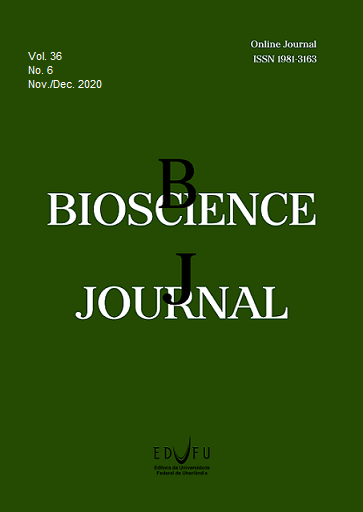Liquid nitrogen fertilization on the yield and phenologic variables of narrow-row cotton
DOI:
https://doi.org/10.14393/BJ-v36n6a2020-48156Keywords:
NDVI., Nitrogen., Correlation., Cotton.Abstract
Slow-release liquid nitrogen fertilizer sources have been around since 1970. However, this technique is not widely used in the field, probably due to the low cost per ton of nitrogen in the solid form. This study aimed to evaluate the combination of the conventional and slow-release nitrogen fertilization on the yield and phenological variables in a narrow-row cotton crop. Treatments consisted of the combination of the nitrogen fertilizer applied as topdressing in solid form (via soil) and pulverized in the liquid form (via urea formaldehyde - UF): 0% of solid N + 0% of liquid N (0S0L); 100% of solid N + 0% of liquid N (100S0L); 75% of solid N + 25% of liquid N (75S25L); 50% of solid N + 50% of liquid N (50S50L); 25% of solid N + 75% of liquid N (25S75L); e 0% of solid N + 100% of liquid N (0S100L). The cotton crop was phenotypically evaluated at 35, 70, and 130 DAE (Days after emergence) and at the harvest time. The variation between the source of the solid nitrogen fertilizer applied to the soil (ammonium nitrate) and the liquid Nitrogen fertilizer applied by spraying (UF) affects the phenology, physiology, and yield components of the narrow-row cotton crop. The highest yield of the narrow-row cotton crop under the experimental conditions was achieved when 25% of the dose of the solid nitrogen fertilizer was applied as topdressing via soil, and 75% of the dose of the slow-release nitrogen fertilizer was sprayed. This technique provides higher profitability of the produced cotton in relation to the conventional application of the N solid fertilizer via soil.
Downloads
Published
Issue
Section
License
Copyright (c) 2020 Denis de Matos Silva, Fabio Henrique Rojo Baio, Cid Naudi da Silva Campos, Simone Pereira da Silva Baio, Danilo Carvalho Neves, Eder Eujácio da Silva, Paulo Eduardo Teodoro

This work is licensed under a Creative Commons Attribution 4.0 International License.





